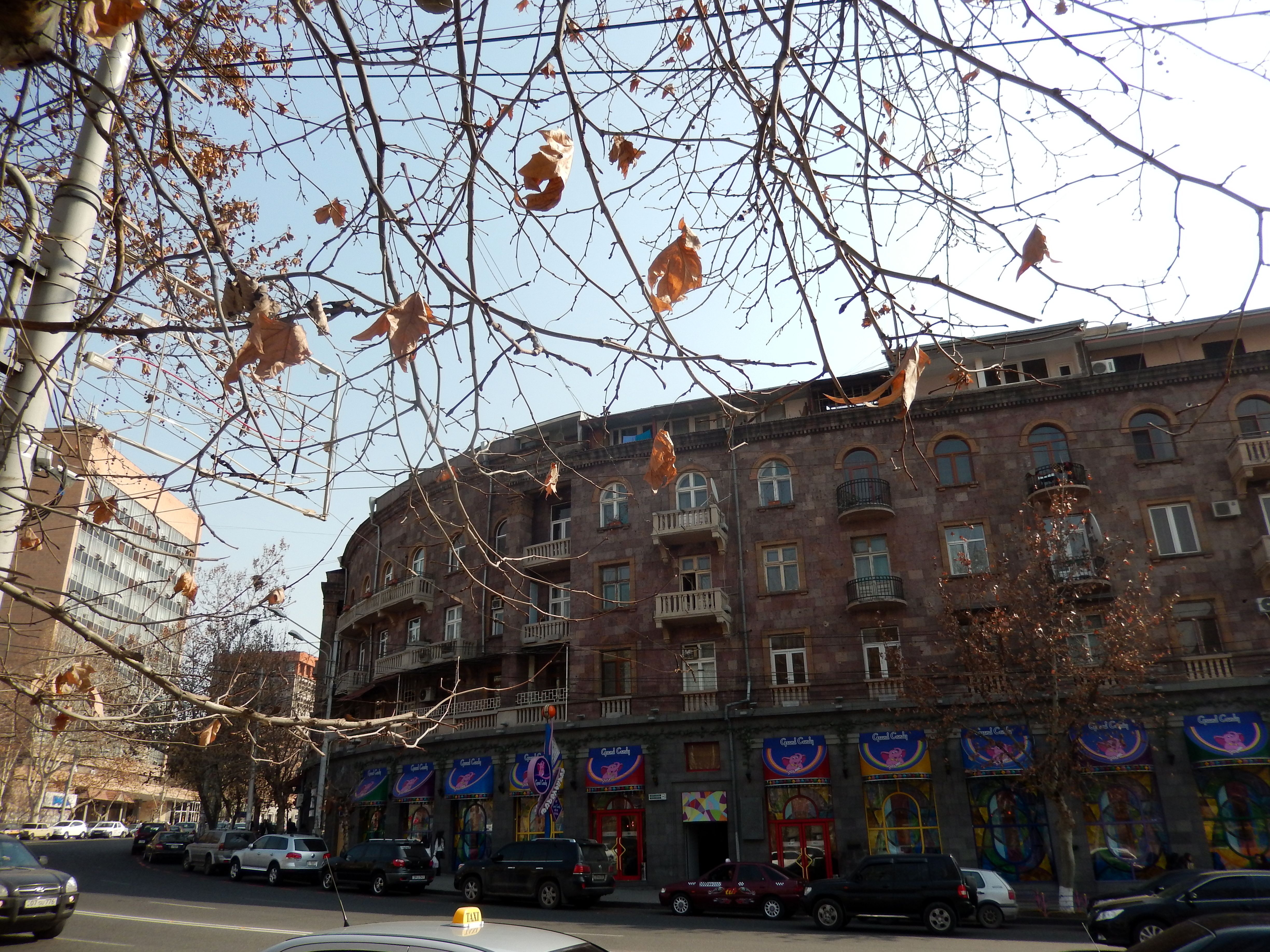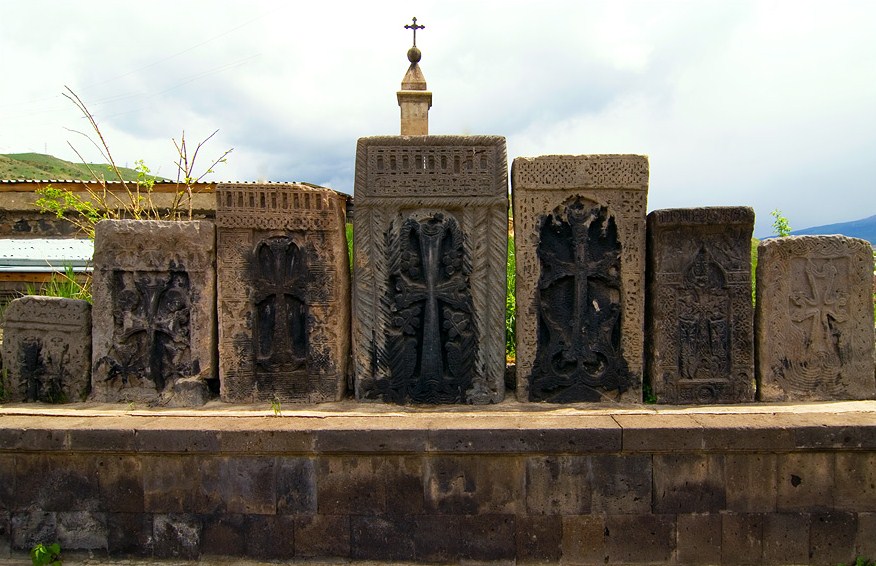|
Anna Ter-Avetikian
Anna Ter-Avetikian ( hy, Աննա Տեր-Ավետիքյան, russian: Анна Тер Аветикян: 10 October 1908 ( O.S.) / 23 October 1908 (N.S.) – 16 January 2013) was the first Armenian woman to become an architect. She designed numerous notable buildings throughout the country and was the recipient of several national prizes for her work. Early life Anna Tigranovna Ter-Avetikian was born on 23 October 1908 in Yerevan, which at the time was in the Erivan Governorate of the Russian Empire. At the time that Armenia was annexed to Russia from the Ottoman Empire, her ancestors were granted a noble title from Nicholas I of Russia for providing assistance and medical supplies to General Ivan Paskevich's troops. She came from a family of architects and city developers who were noted for creating such works as the first drinking water system of Yerevan, the first hospital of the city, as well as other landmarks. Her father, Tigran Ter-Avetikian and his brother, Yervand, created ... [...More Info...] [...Related Items...] OR: [Wikipedia] [Google] [Baidu] |
Yerevan
Yerevan ( , , hy, Երևան , sometimes spelled Erevan) is the capital and largest city of Armenia and one of the world's List of oldest continuously inhabited cities, oldest continuously inhabited cities. Situated along the Hrazdan River, Yerevan is the administrative, cultural, and industrial center of the country, as its primate city. It has been the Historical capitals of Armenia, capital since 1918, the Historical capitals of Armenia, fourteenth in the history of Armenia and the seventh located in or around the Ararat Plain. The city also serves as the seat of the Araratian Pontifical Diocese, which is the largest diocese of the Armenian Apostolic Church and one of the oldest dioceses in the world. The history of Yerevan dates back to the 8th century BCE, with the founding of the fortress of Erebuni Fortress, Erebuni in 782 BCE by King Argishti I of Urartu, Argishti I of Urartu at the western extreme of the Ararat Plain. Erebuni was "designed as a great administrative an ... [...More Info...] [...Related Items...] OR: [Wikipedia] [Google] [Baidu] |
Oscar Niemeyer
Oscar Ribeiro de Almeida Niemeyer Soares Filho (15 December 1907 – 5 December 2012), known as Oscar Niemeyer (), was a Brazilian architect considered to be one of the key figures in the development of modern architecture. Niemeyer was best known for his design of civic buildings for Brasília, a planned city that became Brazil's capital in 1960, as well as his collaboration with other architects on the headquarters of the United Nations in New York. His exploration of the aesthetic possibilities of reinforced concrete was highly influential in the late 20th and early 21st centuries. Both lauded and criticized for being a "sculptor of monuments", Niemeyer was hailed as a great artist and one of the greatest architects of his generation by his supporters. He said his architecture was strongly influenced by Le Corbusier, but in an interview, assured that this "didn't prevent isarchitecture from going in a different direction".Salvaing, Matthieu (2002) ''Oscar Niemeyer''. ... [...More Info...] [...Related Items...] OR: [Wikipedia] [Google] [Baidu] |
Armenian Soviet Socialist Republic
The Armenian Soviet Socialist Republic,; russian: Армянская Советская Социалистическая Республика, translit=Armyanskaya Sovetskaya Sotsialisticheskaya Respublika) also commonly referred to as Soviet Armenia or Armenia, ; rus, Армения, r=Armeniya, p=ɐrˈmʲenʲɪjə) was one of the constituent republics of the Soviet Union in December 1922 located in the South Caucasus region of Eurasia. It was established in December 1920, when the Soviets took over control of the short-lived First Republic of Armenia, and lasted until 1991. Historians sometimes refer to it as the Second Republic of Armenia, following the demise of the First Republic. As part of the Soviet Union, the Armenian SSR transformed from a largely agricultural hinterland to an important industrial production center, while its population almost quadrupled from around 880,000 in 1926 to 3.3 million in 1989 due to natural growth and large-scale influx of Armenian genoci ... [...More Info...] [...Related Items...] OR: [Wikipedia] [Google] [Baidu] |
Supreme Soviet
The Supreme Soviet (russian: Верховный Совет, Verkhovny Sovet, Supreme Council) was the common name for the legislative bodies (parliaments) of the Soviet socialist republics (SSR) in the Union of Soviet Socialist Republics (USSR). These soviets were modeled after the Supreme Soviet of the USSR, established in 1938, and were nearly identical. State-approved delegates to the Supreme Soviets were periodically elected unopposed in show elections. The first free or semi-free elections took place during ''perestroika'' in late 1980s, in which Supreme Soviets themselves were no longer directly elected. Instead, Supreme Soviets were appointed by directly-elected Congresses of People's Deputies based somewhat on the Congresses of Soviets that preceded the Supreme Soviets. The soviets until then were largely rubber-stamp institutions, approving decisions handed to them by the Communist Party of the USSR or of each SSR. The soviets met infrequently (often only twice a yea ... [...More Info...] [...Related Items...] OR: [Wikipedia] [Google] [Baidu] |
Arcade (architecture)
An arcade is a succession of contiguous arches, with each arch supported by a colonnade of columns or piers. Exterior arcades are designed to provide a sheltered walkway for pedestrians. The walkway may be lined with retail stores. An arcade may feature arches on both sides of the walkway. Alternatively, a blind arcade superimposes arcading against a solid wall. Blind arcades are a feature of Romanesque architecture that influenced Gothic architecture. In the Gothic architectural tradition, the arcade can be located in the interior, in the lowest part of the wall of the nave, supporting the triforium and the clerestory in a cathedral, or on the exterior, in which they are usually part of the walkways that surround the courtyard and cloisters. Many medieval arcades housed shops or stalls, either in the arcaded space itself, or set into the main wall behind. From this, "arcade" has become a general word for a group of shops in a single building, regardless of the architectural f ... [...More Info...] [...Related Items...] OR: [Wikipedia] [Google] [Baidu] |
Armenian Architecture
Armenian architecture comprises architectural works with an aesthetic or historical connection to the Armenian people. It is difficult to situate this architectural style within precise geographical or chronological limits, but many of its monuments were created in the regions of historical Armenia, the Armenian Highlands. The greatest achievement of Armenian architecture is generally agreed to be its medieval churches and seventh century churches, though there are different opinions precisely in which respects. Common characteristics of Armenian architecture Medieval Armenian architecture, and Armenian churches in particular, have several distinctive features, which some believe to be the first national style of a church building. [...More Info...] [...Related Items...] OR: [Wikipedia] [Google] [Baidu] |
Classical Architecture
Classical architecture usually denotes architecture which is more or less consciously derived from the principles of Greek and Roman architecture of classical antiquity, or sometimes even more specifically, from the works of the Roman architect Vitruvius. Different styles of classical architecture have arguably existed since the Carolingian Renaissance, and prominently since the Italian Renaissance. Although classical styles of architecture can vary greatly, they can in general all be said to draw on a common "vocabulary" of decorative and constructive elements. In much of the Western world, different classical architectural styles have dominated the history of architecture from the Renaissance until the second world war, though it continues to inform many architects to this day. The term ''classical architecture'' also applies to any mode of architecture that has evolved to a highly refined state, such as classical Chinese architecture, or classical Mayan architecture. It can ... [...More Info...] [...Related Items...] OR: [Wikipedia] [Google] [Baidu] |
Nor Bayazet
Gavar ( hy, Գավառ) is a town and urban municipal community in Armenia serving as the administrative centre of Gegharkunik Province. It is situated among the high mountains of Gegham range to the west of Lake Sevan, with an average height of 1982 meters above sea level. Located 98 kilometers east of the capital Yerevan, the town had a population of 20,765 as per the 2011 census. As per the 2016 official estimate, the population of Gavar is 19,500. Gavar is the seat of the Diocese of Gegharkounik of the Armenian Apostolic Church. Etymology The town was known as ''Nor Bayаzet'' (Նոր Բայազետ) or ''Novo-Bayazet'' () until 1959, named after the Western Armenian town of Bayazet (historically known as ''Daroynk'' and ''Arshakavan''). Between 1959 and 1995, the town was known as ''Kamo'', named after the Bolshevik revolutionary Kamo (Simon Ter-Petrosian). On December 4, 1995, the town was renamed back to its ancient name of ''Gavar'', meaning ''county'' in the Armenian ... [...More Info...] [...Related Items...] OR: [Wikipedia] [Google] [Baidu] |
Stepanavan
Stepanavan ( hy, Ստեփանավան), is a town and municipal community in the Lori Province of Armenia Armenia (), , group=pron officially the Republic of Armenia,, is a landlocked country in the Armenian Highlands of Western Asia.The UNbr>classification of world regions places Armenia in Western Asia; the CIA World Factbook , , and ''Ox .... It is located 139 km north of the capital Yerevan and 24 km north of the provincial centre Vanadzor, halfway between Yerevan and Tbilisi. As of the 2011 census, the population of the town is 13,086. Currently, the town has an approximate population of 10,800 as per the 2016 official estimate. Due to its location on the shores of Dzoraget River among the forest of Lori plateau and Bazum mountains, Stepanavan is considered a resort town in northern Armenia. Etymology Stepanavan was founded in 1810 as ''Jalaloghli'', literally meaning ''son of Jalal'' in Turkic languages. The name is derived from the Armenian noble fami ... [...More Info...] [...Related Items...] OR: [Wikipedia] [Google] [Baidu] |
Leninakan
Gyumri ( hy, Գյումրի, ) is an urban municipal community and the second-largest city in Armenia, serving as the administrative center of Shirak Province in the northwestern part of the country. By the end of the 19th century, when the city was known as Alexandropol,; hy, Ալեքսանդրապոլ it became the largest city of Russian-ruled Eastern Armenia with a population above that of Yerevan. The city became renown as a cultural hub, while also carrying significance as a major center of Russian troops during Russo-Turkish wars of the 19th century. The city underwent a tumultuous period during and after World War 1. While Russian forces withdrew from the South Caucasus due to the October Revolution, the city became host to large numbers of Armenian refugees fleeing the Armenian Genocide, in particular hosting 22,000 orphaned children in around 170 orphanage buildings. It was renamed to Leninakan; russian: Ленинакан during the Soviet period and became a major in ... [...More Info...] [...Related Items...] OR: [Wikipedia] [Google] [Baidu] |
Kirovakan
Vanadzor ( hy, Վանաձոր) is an urban municipal community and the third-largest city in Armenia, serving as the capital of Lori Province in the northern part of the country. It is located about north of the capital Yerevan. As of the 2011 census, the city had a population of 86,199, down from 148,876 reported at the 1979 official census. Currently, the town has a population of approximately 76,200. Vanadzor is the seat of the Diocese of Gougark of the Armenian Apostolic Church. Etymology Vanadzor was previously known as ''Gharakilisa'' (), meaning "black church" in Turkic. In the official records of the Russian Empire, the city was labelled as ''Karakilis Bolshoye'' (). Following the Sovietization of Armenia, the city was renamed ''Martunashen'' (, alternatively ''Martunakan'') in 1926 after Armenian Bolshevik revolutionary Alexander Miasnikian. On 3 January 1935, it was renamed ''Kirovakan'' (), after the popular Russian Bolshevik leader Sergey Kirov. A close associate of A ... [...More Info...] [...Related Items...] OR: [Wikipedia] [Google] [Baidu] |






